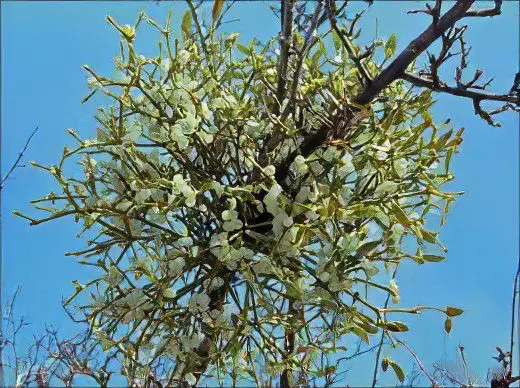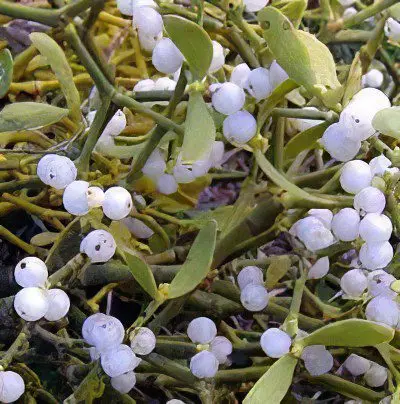Contents
Useful properties and uses of mistletoe
Botanical characteristics of mistletoe

Mistletoe – This is a perennial evergreen parasitic plant, the height of which can vary from 20 to 120 cm. Woody, bare branches break easily. Mistletoe roots easily penetrate the wood and bark of the host tree. Pale green leaves are oblong with parallel venation. The leaves are arranged in pairs on the branches.
Mistletoe blooms in March and April. Inconspicuous flowers appear at the ends of the shoots. The fruit of the plant is presented in the form of a spherical one-seeded berry. When ripe, the false berry acquires a white tint. The seed, which ripens in September, is quite large and covered with a slimy pulp. This herb is very common in the European part of Russia. Mistletoe parasitizes coniferous and deciduous trees, and one of the species parasitizes willow.
Useful properties of mistletoe
Mistletoe contains organic acids, carbohydrates, rubber, triterpenoids, steroids, phenols, cardenolides, flavonoids, triterpene saponins, and higher fatty acids. The infusion of this wonderful herb has soothing, astringent, diuretic, hemostatic, wound healing, analgesic, anticonvulsant, laxative and anti-inflammatory properties. Mistletoe contributes to a noticeable decrease in blood pressure and perfectly strengthens the immune system. Moreover, taking mistletoe can significantly increase the flow of milk in nursing mothers. It should be noted that in ancient times mistletoe was used for various tumors.
Application of mistletoe
In pharmacology, young stems and leaves of the plant are mainly used. Branches of white mistletoe are an effective remedy for hypertension. Along with this, mistletoe is an excellent tonic for various intestinal ailments. When bleeding, it is recommended to use a liquid extract from the leaves. White mistletoe can be an adjunct in the treatment of hypertension. In addition, it can be used for a quick recovery after severe infectious diseases. In folk medicine, mistletoe is often used for dizziness, as well as for hemorrhoidal or uterine bleeding. An aqueous decoction will quickly help with headaches, asthma, diarrhea and prolonged menstruation.
Mistletoe tincture. Such a tool helps to cleanse the blood vessels, improving blood circulation. Also, the tincture reduces the excitability of the nervous system and restores metabolism. It is noted that it is able to suppress the division of tumor cells. In order to make a tincture, you will need 50 grams of mistletoe and 500 grams of vodka. The mixture should be insisted in a dark place for exactly 30 days, and then take 40 drops 4 times a day.
mistletoe flowers. This plant has simple yellowish leaves. Preparations from mistletoe flowers can be taken for inflammatory diseases of the kidneys and for atherosclerosis.
mistletoe branch. This part of the plant is extremely effective for dizziness. You need to take 1 teaspoon of chopped mistletoe branches and pour them with 200 grams of warm water. The mixture should be infused for at least 2-3 hours, after which it can be taken 70 ml three times a day. You can also brew a similar tea from mistletoe twigs and leaves.
mistletoe berries are used in official medicine in special medicines.
mistletoe leaves. In diabetes mellitus, 1 teaspoon of a mixture of mistletoe leaves is poured into 200 grams of warm water. It is recommended to take this remedy 100 ml three times a day. As a rule, courses of treatment are 14-21 days.
mistletoe

White mistletoe is a unique evergreen shrub from the belt family. Such a plant prefers to grow on the branches of other trees, choosing shoots of pear, poplar, apple, willow, white locust, linden, birch, pine, maple and hawthorn. Mistletoe causes serious damage to fruit trees. Numerous branches form spherical bushes up to 120 cm in diameter. Mistletoe has green bark and opposite leaves. The flowers of the plant are collected in axillary inflorescences. The fruit is a juicy round berry containing 2-3 seeds. White mistletoe blooms in March, and the berries ripen only in August. You can meet such a plant in North Africa, Southern Europe and Asia Minor. In addition, this species feels great in the southern regions of Russia.
Mistletoe willow
Willow mistletoe is an unusual plant that parasitizes on the tops and branches of willows. It grows into a large dense bush of a spherical shape. Such a shrub has thin twigs and paired leaves.
mistletoe red
Mistletoe red is a parasitic shrub plant that is distinguished by flexible thin stems and purple berries. The fruit is dressed in sticky pulp, where one or two seeds are located. Often the plant can be found on maples, poplars and birches. Red mistletoe consumes minerals and moisture from the host tree itself. On the tops of trees, mistletoe creates round bushes up to one meter in diameter.
Contraindications to the use of mistletoe
It has been proven that with frequent or prolonged use of drugs from the herb presented, poisoning of the body occurs. Moreover, mistletoe is not recommended during pregnancy, low blood pressure, and low thyroid function.









